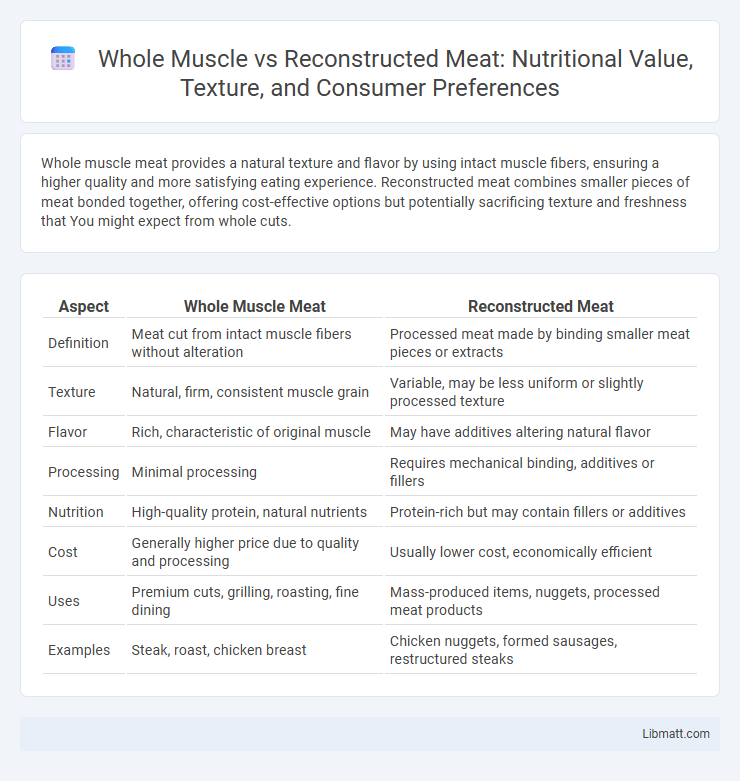Whole muscle meat provides a natural texture and flavor by using intact muscle fibers, ensuring a higher quality and more satisfying eating experience. Reconstructed meat combines smaller pieces of meat bonded together, offering cost-effective options but potentially sacrificing texture and freshness that You might expect from whole cuts.
Table of Comparison
| Aspect | Whole Muscle Meat | Reconstructed Meat |
|---|---|---|
| Definition | Meat cut from intact muscle fibers without alteration | Processed meat made by binding smaller meat pieces or extracts |
| Texture | Natural, firm, consistent muscle grain | Variable, may be less uniform or slightly processed texture |
| Flavor | Rich, characteristic of original muscle | May have additives altering natural flavor |
| Processing | Minimal processing | Requires mechanical binding, additives or fillers |
| Nutrition | High-quality protein, natural nutrients | Protein-rich but may contain fillers or additives |
| Cost | Generally higher price due to quality and processing | Usually lower cost, economically efficient |
| Uses | Premium cuts, grilling, roasting, fine dining | Mass-produced items, nuggets, processed meat products |
| Examples | Steak, roast, chicken breast | Chicken nuggets, formed sausages, restructured steaks |
Introduction to Whole Muscle and Reconstructed Meat
Whole muscle meat refers to cuts that come directly from a single part of an animal, such as steaks, chops, or roasts, retaining natural muscle fibers and texture. Reconstructed meat is produced by combining smaller pieces of muscle, often from various sources, which are bound together using agents like transglutaminase to form a cohesive product. Understanding these definitions is key to distinguishing quality, texture, and processing methods in meat products.
Defining Whole Muscle Meat
Whole muscle meat refers to cuts of meat derived directly from the muscles of animals, retaining their natural, intact structure and texture. These cuts, such as steaks, roasts, or chops, preserve the original muscle fibers and connective tissues, offering superior tenderness and flavor compared to processed alternatives. Unlike reconstructed meat, whole muscle meat undergoes minimal processing, ensuring a more authentic eating experience and higher nutritional value.
What is Reconstructed Meat?
Reconstructed meat consists of small pieces of muscle tissue that are mechanically separated and then combined using binders, additives, or enzymes to form a product resembling whole muscle meat. This process allows for the efficient use of meat trimmings and enhances texture and appearance, making it cost-effective compared to whole muscle cuts. Commonly found in products like imitation crab meat, chicken nuggets, and formed steaks, reconstructed meat differs significantly from whole muscle meat, which is cut directly from the intact muscle without further processing or binding.
Key Differences in Production Methods
Whole muscle meat is sourced directly from the muscle tissue of animals, involving minimal processing such as cutting, trimming, and packaging. Reconstructed meat, also known as restructured or formed meat, is produced by binding smaller pieces of meat or meat substitutes using additives, enzymes, or mechanical processes to create uniform shapes and textures. Whole muscle production preserves the natural muscle fiber integrity, whereas reconstructed meat relies on advanced techniques for texture uniformity and often incorporates binders and fillers.
Nutritional Comparison: Whole Muscle vs Reconstructed Meat
Whole muscle meat retains a higher concentration of intact proteins, essential amino acids, and naturally occurring micronutrients such as iron, zinc, and vitamin B12 compared to reconstructed meat, which often contains added binders and fillers that alter its nutritional profile. Reconstructed meat products may have increased sodium and preservatives to enhance shelf life and texture but typically offer lower bioavailability of nutrients due to processing. Consumers seeking optimal nutrient density benefit more from whole muscle cuts, which provide a more natural matrix of nutrients critical for muscle maintenance and overall health.
Texture and Flavor Profiles
Whole muscle meat offers a firmer texture with well-defined grain structures and a natural juiciness that enhances flavor depth, delivering a rich, savory taste. Reconstructed meat products exhibit a uniform texture that can be softer or denser depending on processing techniques, often with a milder flavor due to blending and added binders. Flavor profiles in whole muscle cuts are more intense and complex, while reconstructed meat tends to provide consistent but less nuanced taste experiences.
Safety and Health Considerations
Whole muscle meats, such as steaks and roasts, generally pose fewer food safety risks than reconstructed meats because they have intact muscle fibers that delay bacterial penetration. Reconstructed meats, made from smaller meat pieces bound together, often require stricter processing controls to prevent contamination and ensure even cooking to kill pathogens. From a health perspective, whole muscle cuts typically have less sodium and fewer additives compared to processed or reconstructed meat products, which may contain binders, preservatives, and higher fat content.
Environmental Impact and Sustainability
Whole muscle meat generally has a lower environmental impact compared to reconstructed meat due to less energy-intensive processing and fewer additives required. Reconstructed meat production often involves higher greenhouse gas emissions, water usage, and energy consumption, raising sustainability concerns. Sustainable practices in whole muscle meat sourcing, such as regenerative agriculture, further reduce its ecological footprint.
Consumer Preferences and Market Trends
Consumer preferences increasingly favor whole muscle meat for its natural texture, flavor, and perceived health benefits, driving market demand for premium cuts. However, reconstructed meat gains traction due to affordability, sustainability, and innovative processing techniques that mimic whole muscle qualities. Your purchasing decisions can reflect these trends, balancing taste, cost, and environmental impact in the evolving meat market.
Conclusion: Choosing the Right Meat Option
Choosing the right meat option depends on the desired texture, flavor, and nutritional value; whole muscle meat offers a natural, fibrous texture with higher protein retention and minimal processing. Reconstructed meat provides versatility and cost-effectiveness by combining smaller meat pieces, often enriched with additives for enhanced consistency and shelf life. Consumers prioritizing authenticity and nutritional density typically prefer whole muscle cuts, while those seeking affordability and uniformity may opt for reconstructed meat.
Whole Muscle vs Reconstructed Meat Infographic

 libmatt.com
libmatt.com